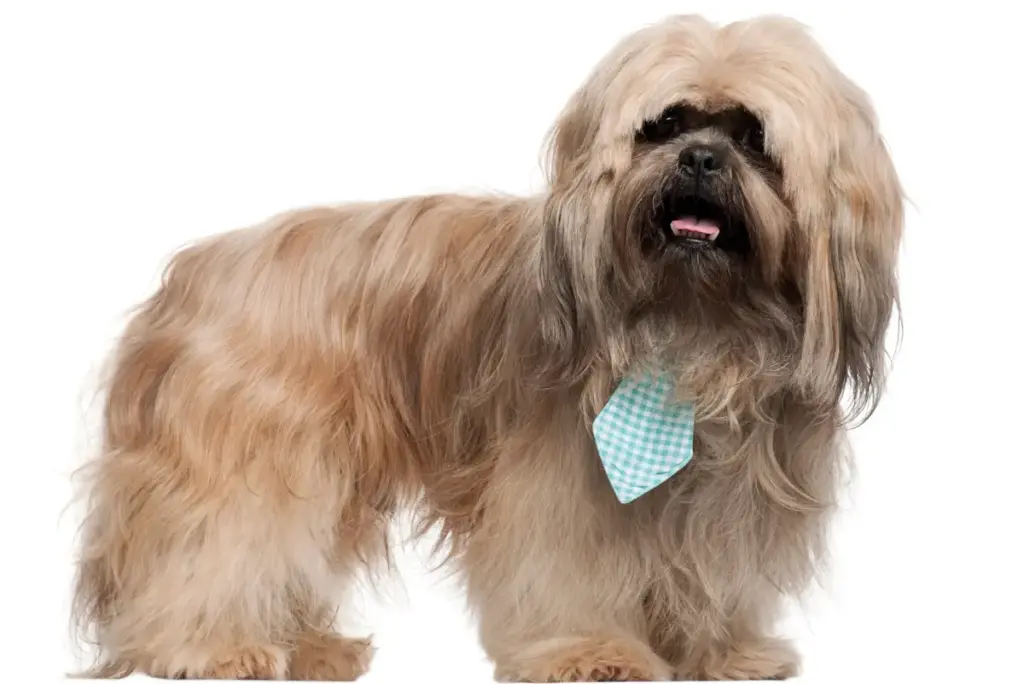Imagine the soft rustling of a luxurious, flowing coat as a dignified Lhasa Apso pads silently across the room. Its regal bearing evokes its storied origins in the Himalayan monasteries. You’ve likely been drawn to their unique blend of stoic independence and loyal companionship, making them an intriguing pet choice.
As you consider welcoming a Lhasa Apso into your life, you’re faced with the nuances of their care—striking a balance between their need for regular grooming and the joy of engaging with their spirited personality. While they may present as compact and manageable, their care routines and temperament layers reveal complexities that beg a closer look.
Navigating these intricacies will reveal the methods for forging a deep bond with this ancient Tibetan companion. Perhaps you’ll find that the Lhasa Apso is not just a pet but a journey into a rich cultural legacy.
- Noise Level
- Energy
- Sociability
- Trainability
- Care
- Health
Overall
Summary
The Lhasa Apso is moderately rated across various characteristics, with average noise level and energy, good sociability, moderate trainability, and high requirements for care and health maintenance.
Lhasa Apso: Traits, Temperament, and Care Guide
Delving into the Lhasa Apso breed, you’ll find its traits include a robust yet small stature complemented by a luxurious, flowing coat that epitomizes its alert and self-reliant character. Originating from the Tibetan monasteries, this breed carries the regal air of its ancient heritage.
Their affectionate temperament towards family contrasts with a reserved demeanor around strangers, necessitating early socialization. Small dogs with moderate energy require consistent, albeit not excessive, exercise—about an hour daily.
Your Lhasa Apso’s coat maintenance demands a firm commitment to regular grooming to prevent mats and tangles. Attentive care also involves vigilance for health issues like kidney dysfunction and eye problems, making routine veterinary check-ups and dental care indispensable parts of their care guide.
Thus, you’ll ensure your companion’s well-being and fortify the bond you share.
Exploring the Characteristics of the Lhasa Apso
As we explore the Lhasa Apso’s distinct characteristics further, it becomes clear that their small stature, ranging from 9 to 11 inches in height and weighing between 13 and 18 pounds, is complemented by a long, luxurious coat in various colors. This breed, descended from the Tibetan terrier, is built for the cold weather of Tibet, with a coat that provides insulation.
| Feature | Description |
|---|---|
| Size | Small (9-11 inches, 13-18 pounds) |
| Coat | Long, various colors, requires grooming |
| Exercise | Moderate (20 minutes/day) |
| Socialization | Needs to be well socialized |
Lhasa Apsos thrive when they’re well-socialized, displaying affection to familiar faces and a spirited presence at home. Despite their small size, they retain a robust energy that’s well-managed with a moderate amount of exercise.

Lhasa Apso: A Comprehensive Profile and Guide
As you explore the Lhasa Apso breed, you’ll find they embody a balance of independence and companionship.
Their specific grooming needs and exercise patterns cater to a lifestyle that values aesthetics and moderate activity.
Understanding their social tendencies and potential health concerns is crucial for fostering a long-lasting relationship with your pet.
Everything You Need to Know
Understanding the Lhasa Apso breed involves exploring its distinctive characteristics. This small yet hardy companion typically has a height of 10 to 11 inches and a weight of 12 to 18 pounds. One of its most notable features is its long, dense coat in various colors. The Lhasa Apso’s history is also significant, as it was once the sentinel for Tibetan Dalai Lamas, reflecting its deep historical importance.
Here are some essential points to consider when caring for a Lhasa Apso:
- Lifespan: Lhasa Apsos can live for many years, and proper care can contribute to their longevity. Providing them with a healthy lifestyle and regular veterinary check-ups is essential.
- Grooming: Lhasa Apsos require regular brushing to prevent matting due to their long, dense coat. They may also need professional grooming to maintain their coat’s health and appearance.
- Recognition: The American Kennel Club classifies Lhasa Apsos as a non-sporting group. This classification acknowledges their unique characteristics and distinguishes them from other breeds.
- Socialization: Proper socialization is crucial for Lhasa Apsos to develop a well-rounded personality. They are known to be affectionate, yet selectively aloof. Exposure to various people, animals, and environments early can help them become more comfortable and adaptable.
Incorporating these elements into their care will ensure a well-adjusted and happy Lhasa Apso.
Discovering the Temperament
Peeling back the layers of the Lhasa Apso temperament reveals a breed that combines affectionate loyalty towards family with a cautious demeanor around strangers, embodying the dual nature of a companionable pet and a vigilant watchdog.
These dogs are alert and lively, yet they can display an assertive, regal nature indicative of their Tibetan heritage where they were considered bearers of good luck.
While they can be aloof with strangers, a properly socialized Lhasa Apso is likelier to exhibit a well-rounded temperament.
Their intelligence and independence can make training challenging, but with positive reinforcement, they will respond enthusiastically.
Remember, they have a sense of humor, so expect your interactions to be as entertaining as they are rewarding.
Lhasa Apso: Is It a Good Fit for Families?
You may wonder if a Lhasa Apso fits well within your family dynamic, especially if you have young children or other pets. Given their loyal nature to family members contrasted with a cautious demeanor around strangers, early socialization and consistent training are crucial for integrating this breed into a household.
Their need for regular grooming and moderate exercise aligns with a family prepared for an active involvement in their pet’s care regimen.
Assessing Lhasa Apso’s Compatibility with Families and Kids
When considering a Lhasa Apso for your family, it’s important to recognize that while they’re generally good with children, their less sociable nature towards other dogs may best suit a single-pet household. Their temperament is one where loyalty and protectiveness come to the fore, suggesting they can be excellent companions for families.
Here are factors to consider for compatibility:
- Socialization: Early and consistent socialization helps develop a well-adjusted Lhasa Apso that enjoys kids’ companionship.
- Training: Commit to training to manage their independence, ensuring harmony with family dynamics.
- Activity Level: They require regular exercise, aligning with active families.
- Alone Time: Lhasa Apsos can handle alone time, accommodating various family schedules.
Lhasa Apso Climate Resilience
Thanks to their dense, insulating double coats, Lhasa Apsos exhibit remarkable adaptability to diverse climates, from the biting cold of high-altitude regions to more temperate zones.
Their historical role as indoor watchdogs in the Himalayas has shaped them into a hardy and healthy breed, able to cope with harsh weather conditions.
In moderate climates, they thrive when you give their coats the attention they need.

Lhasa Apso Training Essentials
As you approach training your Lhasa Apso, you must employ consistent, positive reinforcement techniques that align with their intelligent yet willful temperament. You must integrate early socialization and obedience training to manage their innate assertiveness, ensuring they develop into well-adjusted companions.
Allocating at least an hour daily for exercises, including physical activities and cognitive challenges, is critical for their well-being and receptivity to training.
Effective Training Strategies
To effectively train your Lhasa Apso, it’s essential to employ positive reinforcement techniques, offering treats and praise to encourage desired behaviors. Start training as soon as your little dog joins your family. This instills good habits early on and helps your Lhasa Apso: Dog learn to adapt and readily accept new things. Remember, consistency is key to keep Lhasa Apsos focused and responsive to your commands.
Here’s a table summarizing the training strategies:
| Strategy | Benefit |
|---|---|
| Positive Reinforcement | Encourages desired behavior |
| Early Socialization | Promotes adaptability and good manners |
| Consistent Commands | Fosters obedience and understanding |
| Varied Training Sessions | Keeps training engaging and combats stubbornness |
| Daily Exercise & Playtime | Ensures physical and mental stimulation |
Integrating these approaches will help you and your Lhasa Apso enjoy a harmonious relationship, whether they’re sporting a puppy cut or a full coat.
Exercise and Grooming Needs
Ensuring your Lhasa Apso receives at least 20 minutes of daily exercise is crucial for their physical and mental well-being. As apartment dogs known for their adaptability, they thrive with short walks and play sessions that cater to their energy levels.
Beyond exercise, your Lhasa Apso’s grooming needs are paramount. Their luxurious show coat demands daily brushing to avoid matting and tangling. Your commitment to their grooming extends to regular ear cleaning and brushing their teeth every week to promote optimal health.
Professional grooming is advisable every 4-6 weeks to keep their coat clipped fairly and manageable. This practice maintains their aesthetic appeal and ensures debris removal, contributing to their vivacious spirit post-grooming.
Health Considerations
When considering a Lhasa Apso’s health, be aware that they’re susceptible to specific ailments, such as kidney dysfunction and progressive retinal atrophy.
You’ll need to provide them with a diet that supports their unique health requirements and a lifestyle conducive to their longevity.
Consistent veterinary care is essential to manage these conditions and can contribute to a lifespan that often reaches into the mid-teens.
Common Health Issues and Lifespan
Lhasa Apsos typically enjoy a lifespan of 12 to 15 years. However, they are susceptible to certain health issues, including kidney dysfunction and progressive retinal atrophy. When you buy a Lhasa, you must be aware of these common health challenges.
Dry eye, luxating patella, and hip dysplasia can also affect this ancient breed, treasured by Tibetan monks years ago. Proper grooming and dental care are non-negotiable to prevent issues that could shorten their lifespan. Exercise is equally crucial for maintaining overall fitness.
Every day, you must provide your Lhasa Apso with a high-quality diet and ensure regular veterinary check-ups to catch any concerns early. Remember, a well-cared-for Lhasa is a companion never sold short on health and happiness.
Alternatives for Lhasa Apso: Charming and Independent Small Breeds
If captivated by the Lhasa Apso’s charm and independence, consider these small breeds known for their distinctive personalities and companionable nature.
| Similar Dogs | Short Description |
|---|---|
| Shih Tzu | Known for its affectionate nature and luxurious coat, ideal for companionship. |
| Tibetan Terrier | A breed with a similar origin, known for its playful character and loyalty. |
| Pekingese | A regal breed with a distinctive appearance and loyal nature. |
| Maltese | A gentle and affectionate toy breed, known for its luxurious white coat. |
| Havanese | A playful and friendly breed, great for families and adaptable to various lifestyles. |
Is Lhasa Apso the Right Dog for You?
When considering a Lhasa Apso as a pet, you should be ready to commit to their need for regular grooming and daily exercise. This breed thrives when it’s part of a family that understands its affectionate nature with familiar faces while also respecting its initial wariness around strangers. As a potential owner, you’d need to nurture its moderate energy levels with consistent activities.
Barking is a notable trait; investing in training to manage their vocal tendencies is essential. Health-wise, while generally robust, Lhasa Apsos have breed-specific concerns you should be aware of. If you’re seeking a loyal companion slightly smaller than a Shih Tzu, keeping a Lhasa Apso could enrich your life.
Conclusion
In conclusion, the Lhasa Apso is like a small, intricate tapestry—rich in detail and requiring careful maintenance. Your diligence in grooming and health monitoring ensures this regal companion thrives.
With proper training and affection, they’ll mesh with your family as seamlessly as threads in silk. Choose a Lhasa if you’re ready for a dog with a lion’s heart and the loyalty of a lifelong confidant, all wrapped in a luxuriant, flowing coat.
